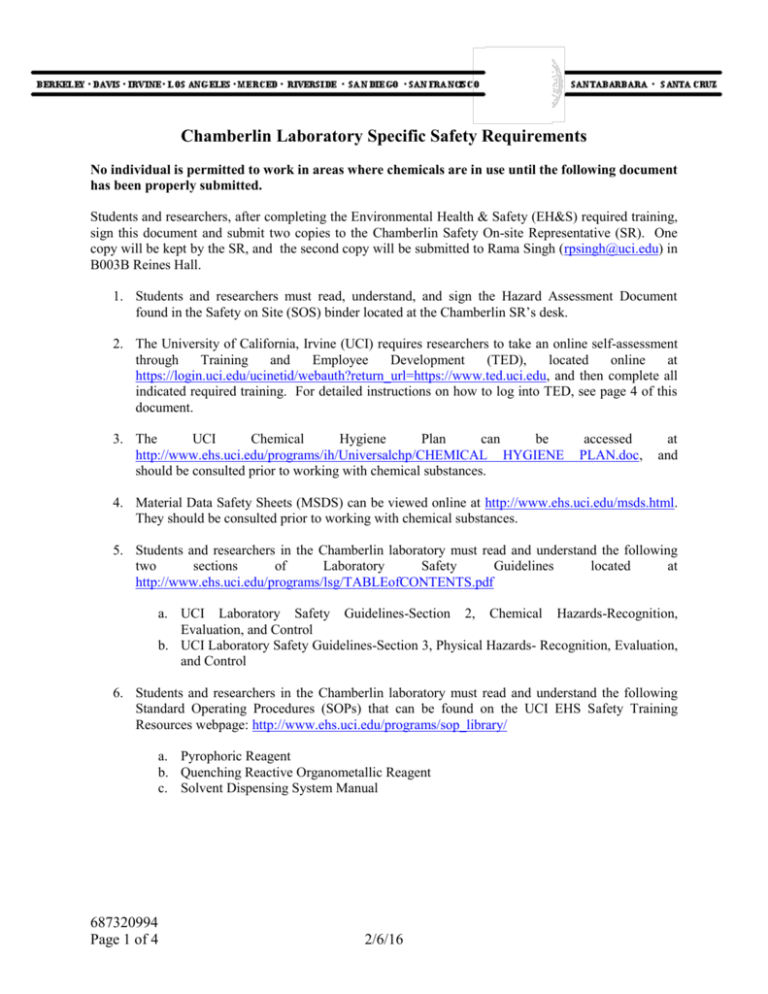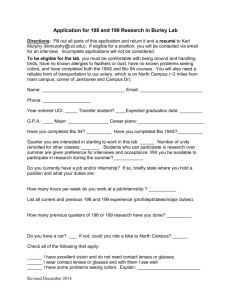Lab Specific Training - University of California, Irvine
advertisement

Chamberlin Laboratory Specific Safety Requirements No individual is permitted to work in areas where chemicals are in use until the following document has been properly submitted. Students and researchers, after completing the Environmental Health & Safety (EH&S) required training, sign this document and submit two copies to the Chamberlin Safety On-site Representative (SR). One copy will be kept by the SR, and the second copy will be submitted to Rama Singh (rpsingh@uci.edu) in B003B Reines Hall. 1. Students and researchers must read, understand, and sign the Hazard Assessment Document found in the Safety on Site (SOS) binder located at the Chamberlin SR’s desk. 2. The University of California, Irvine (UCI) requires researchers to take an online self-assessment through Training and Employee Development (TED), located online at https://login.uci.edu/ucinetid/webauth?return_url=https://www.ted.uci.edu, and then complete all indicated required training. For detailed instructions on how to log into TED, see page 4 of this document. 3. The UCI Chemical Hygiene Plan can be http://www.ehs.uci.edu/programs/ih/Universalchp/CHEMICAL HYGIENE should be consulted prior to working with chemical substances. accessed PLAN.doc, at and 4. Material Data Safety Sheets (MSDS) can be viewed online at http://www.ehs.uci.edu/msds.html. They should be consulted prior to working with chemical substances. 5. Students and researchers in the Chamberlin laboratory must read and understand the following two sections of Laboratory Safety Guidelines located at http://www.ehs.uci.edu/programs/lsg/TABLEofCONTENTS.pdf a. UCI Laboratory Safety Guidelines-Section 2, Chemical Hazards-Recognition, Evaluation, and Control b. UCI Laboratory Safety Guidelines-Section 3, Physical Hazards- Recognition, Evaluation, and Control 6. Students and researchers in the Chamberlin laboratory must read and understand the following Standard Operating Procedures (SOPs) that can be found on the UCI EHS Safety Training Resources webpage: http://www.ehs.uci.edu/programs/sop_library/ a. Pyrophoric Reagent b. Quenching Reactive Organometallic Reagent c. Solvent Dispensing System Manual 687320994 Page 1 of 4 2/6/16 7. Students and researchers should understand and follow recommended operating procedures found in the following documents, whenever performing hazardous operations or working with hazardous materials: a. Prudent Practices in the Laboratory: Handling and Disposal of Chemicals (National Academy Press; Washington D.C. 1995, 0309052297) is an excellent resource to consult when dealing with most concerns involving health and safety issues in the laboratory. It also contains safe procedures for the destruction of reactive chemicals (e.g. peroxides, reactive organometallic reagent, oxidizing agents, strongly acidic/basic solutions). There are two copies in the Chamberlin Laboratory. One copy is in the group alcove bookshelf. The other copy resides on the SR’s bookshelf. b. The Chamberlin Safety on Site Binder: Standard Operating Procedures Section contains recommended operating procedures for many operations commonly performed in the Chamberlin laboratory. The procedures include the preparation and/or use of airsensitive reagents, tert-butyl lithium, ozonolysis, Dess-Martin periodinane and 2iodoxybenzoic acid, diazomethane, lithium aluminum hydride, samarium diiodide, strong amide bases, and tri-n-butyl tin hydride. Documents can also be found that describe the proper use of gas regulators, flash chromatography technique, and solutions for cleaning glassware. c. The UCI EHS Safety Training Resources website contains a larger list of SOPs that might also pertain to work performed in the laboratory (http://www.ehs.uci.edu/programs/sop_library/). This site also contains links to lists of carcinogenic, toxic and other hazardous substances. 8. Students and researchers must attend a laboratory specific training performed by the Chamberlin laboratory SR. Topics of this training include: location and proper use of safety equipment, emergency procedures, chemical and solvent storage, and the chemical inventory system. This training also includes a review of special guidelines (Safety Requirements, see page 3) and other hazards specific to the Chamberlin research group. I, , (Print Name) have read and understand the Chamberlin Laboratory Specific Safety Requirements, and I have completed the required training. Signature Date A. Richard Chamberlin Date _____________________________________________________________________________________ SOS Representative Signature Print Name Date 687320994 Page 2 of 4 2/6/16 Chamberlin Group Safety Requirements (11/2009) 1. Except when at one's desk or walking from the hall directly to the desk, safety glasses and laboratory coats must be worn at all times when in the lab. For people with prescription glasses, sideshields must be worn at all times in the lab. 2. Flip-flops (or other open-toed shoes) are not permitted in the lab whenever safety glasses are required. 3. Latex, nitrile, etc. gloves cannot touch doorknobs, computer mice, or other items in clean areas. Chemically contaminated items (lab coats, bottles, TLC plates, NMR tubes, etc.) are not permitted in these areas either. 4. Large scale reactions cannot be performed when alone in the lab. 5. Solvent bottles greater than 1 L cannot be left unattended on bench tops or on the floor. No chemical-containing bottle can be on the floor without secondary containment (attended or not). 6. 5 gallon solvent containers must be stored in flammable storage cabinets; never on the floor. 7. Hazardous operations should not be performed in locations where hazardous materials are stored in bulk (e.g. flame-drying glassware in the presence of organic solvents). 8. No one should work with pyrophoric material and/or Particularly Hazardous Substances (PHS) compounds alone. Prior to working with these types of substances, researchers should consult an appropriate operating procedure and a co-worker who is already familiar with the procedure. 9. A thermometer should be used to monitor any large scale or exothermic reaction. Note: "Large scale" is defined as any reaction in a 1L flask or 50 mmol of substrate in any vessel. 687320994 Page 3 of 4 2/6/16 Signing in to TED 1. Go to the TED homepage (https://login.uci.edu/ucinetid/webauth?return_url=https://www.ted.uci.edu). 2. Login. IF THIS IS YOUR FIRST TIME (most people) you will be asked to enter your supervisor's (SR) email. Enter lab SR’s email address. Then click submit and confirm. 3. You will automatically be directed to the self-assessment page. Click the boxes that describe your lab activities (e.g. Academic, Lab Research, Hazardous Chemicals, Hazardous Waste, Compressed Gas Cylinders). Then submit the changes. 4. You will be directed to the TED website showing your required and recommended training. Some of the required training, such as Hazardous Waste and Laboratory Core Safety, can be taken online through TED by clicking on the required courses. For other required training offered by EH&S in classroom setting, you will need to enroll in those classes online through TED and complete them. 5. Take the required courses. Depending on how many of the pre-course quizzes you pass, this should take between 30 minutes and 3 hours. 6. If your lab duties, activities, or responsibilities change, return to TED and update your selfassessment by clicking the appropriate link on your TED desktop. Additional Chamberlin Lab Member Responsibilities 1. 2. 3. 4. 5. 6. 7. Make sure that waste containers are properly labeled with the waste accumulation start date. Ensure that empty bottles, cans, boxes, etc. are disposed of WEEKLY. Ensure that no chemicals or solvents are stored on the lab floor. Ensure that floors remain uncluttered. Keep at least one explosion shield in lab and in good condition. Ensure that visitors wear safety glasses when in lab. Make sure that acetone bottles are not kept at the sink. Chamberlin Lab Safety Coordinator Responsibilities 1. 2. 3. 4. 5. Check fire extinguishers each month to ensure that they are fully charged. Enforce storage and labeling laws regarding waste, split containers, toxic chemicals, etc. Coordinate quarterly group cleanup and safety inspections. Keep waste storage area tidy. Ensure that Chamberlin Lab Members clean up their own messes in a timely manner. 687320994 Page 4 of 4 2/6/16







